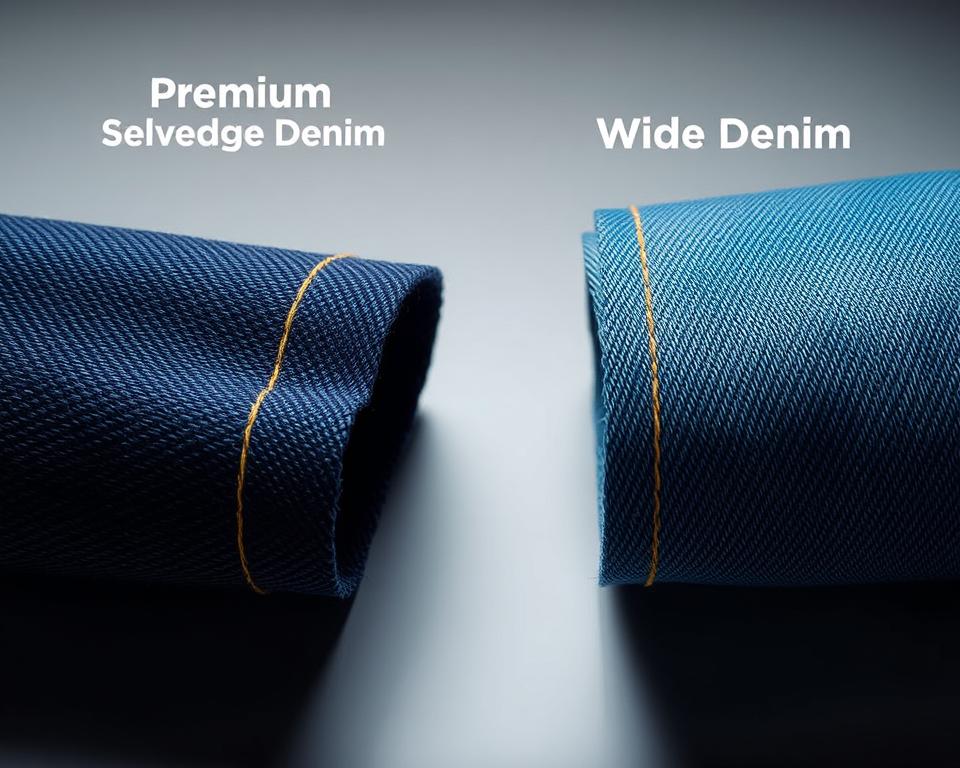Your Guide for High-Quality denim Edge-to-Edge Material
Have you ever questioned why certain jeans seem as though they are built for endurance eternity? Everything revolves around the elements and craftsmanship. For example, the rising popularity of premium selvedge. This goes beyond common textile—it attests to superiority and tradition.
Today, a growing number of people are opting for these everlasting materials for their robustness and classic selvedge denim fabric allure. Whether you’re a DIY sewist or a denim aficionado, there’s an exceptional aspect about using superior natural fiber and thread. It’s not just about making trousers; it centers on fashioning a narrative.
Within Core Fabrics, we’ve selected a selection of 14.25oz organic cotton and stretch variants. Such textiles are ideal for a spectrum ranging from raw trousers to couture jacket blueprints. Ready to explore the realm of top-tier fabrics? Let us delve in.
Defining Denim Selvedge Fabric?
What is it that makes some trousers stand out with their signature, self-finished edges? The key resides in the selvedge denim, a premium textile known for its robustness and retro appeal. In contrast to conventional textiles, such material is fashioned with classic methods that have endured through ages.
The Definition of Selvedge Denim
Selvedge denim is manufactured using old-style shuttle looms, which yield slender widths of about 30-35 inches. They intertwine the material in a manner that ensures self-finished edges, often highlighted by a signature red line. This process ensures the material is densely interlaced and exceptionally sturdy.
Modern looms, in contrast, yield broader fabric but lack the equivalent of skill. The imperfections in selvedge, like leg twists or inconsistent patterns, are accepted as elements of its beauty. This philosophy, often referred to as “wabi-sabi”, honors the aesthetic of organic flaws.
How Selvedge Denim Is Made
The production of selvedge denim involves a meticulous process. Traditional shuttle looms cross the filling yarns in alternating directions, forming a thick and sturdy fabric. This process stands in contrast with contemporary machines, which prioritize rapid output over quality.
Companies such as Karson Denim uphold vintage Japanese methods from the 1990s. They deliberately incorporate flaws to maintain the genuineness of the material. All products is graded on a 4-point system, guaranteeing it satisfies the peak requirements of excellence.
| Characteristic | Selvedge Denim | Current Denim |
|---|---|---|
| Measure | 30-35 inches | 60+ inches |
| Weaving Process | Classic Shuttle Loom | Contemporary Loom |
| Texture | Uneven, Imperfect | Consistent |
| Strength | Exceptional | Standard |
“The allure of selvedge lies in its imperfections—each flaw tells a story craftsmanship and tradition.”
The Legacy of Selvedge Denim
Starting from modest origins to global acclaim, the story of these fabrics is multifaceted and moving. What started as hardwearing clothing in 17th-century France evolved into a symbol of timeless style and artistry.
Origins in Traditional Weaving
The roots of this fabric dates back to Nîmes, France, where it was referred to as “serge de Nîmes.” Initially created for workers, it was constructed with robust cotton and yarn. Its strength made it a favorite among laborers during the historic Gold Rush.
By the 20th century, it had evolved into a cornerstone for jeans. The shuttering of the Cone Mills White Oak plant served as a catalyst. This change enabled Japanese craftsmen to restore old-world weaving methods.

Modern Developments in Denim
After World War II, Japan adopted retro American culture. Artisans revitalized old looms to manufacture true reproductions. This devotion to quality ensured the continuance of selvedge as a niche product.
In modern times, innovations from Italy and Turkey have brought forth eco-friendly combinations and stretch selections. These modernizations have enhanced the attraction of this everlasting fabric. Here at Core Fabrics, we gather worldwide, from Montréal to Asia, to offer you the top-notch standards.
“The legacy of selvedge is a celebration of the enduring value of quality and tradition.”
The Benefits of Selvedge Denim?
What makes selvedge denim distinguish itself in the world of top-tier materials? Its distinct attributes and unmatched durability make it a favorite among lovers and stylists alike. Be it that you are crafting pants or a structured jacket, this fabric provides a fusion of tradition and modern appeal.
Unique Qualities of Selvedge Fabric
Selvedge denim is renowned for its dense construction, which improves tear resistance and wear patterns. Differing from regular textiles, rainbow selvedge denim is crafted using classic shuttle looms, yielding a denser and more durable product. Such a process guarantees that each piece has a distinct surface and character.
Notable attributes are:
- Textured, firm raw denim offers a contrast to laundered, relaxed stretch options.
- Sanforization stabilizes the fabric for consistent measurements, while raw options offer a shrink-to-fit adventure.
- Weight options range from 9.5oz Eco Finish to 14.25oz Organic, suited for varied requirements.
Robustness and Endurance
One of the key attributes of selvedge denim is its longevity. The tighter weave both reinforces strength and permits unique fading patterns over time. This establishes it as a valuable investment for those in pursuit of timeless pieces.
Key points to consider:
- Fabrics weighing between 12oz and 14oz are perfect for form-fitting jackets and jeans that mellow with time.
- The 14.25oz True Indigo option is highly favored for enduring jeans.
- Green alternatives, including recycled cotton with indigo blends, contribute to a sustainable collection.
At Core Fabrics, our collection includes a variety of options to suit your needs. Spanning from raw finishes to sanforized treatments, each selection is designed for superior quality and value.
Selvedge vs. Wide Denim: A Comparison
For making robust and fashionable apparel, the selection of material is pivotal. Among the prevalent selections are selvedge and wide denim, both offering different features. Understanding their differences can help you choose the best option for your project.
Contrasting Weave Techniques
Selvedge denim is crafted with classic shuttle looms, producing slim widths of 30-35 inches. This striped selvedge denim fabric method generates secure finishes, often featuring a signature red line. Conversely, wide denim employs advanced projectile looms, producing expansive widths of over 60 inches.
Traditional shuttle looms operate at approximately 3 meters per minute, while projectile looms can produce up to 30 meters per minute. The variance in production speed affects both the price and the surface quality of the final product.
Advantages and Disadvantages
Selvedge denim is known for its premium quality and durability. Its limited breadth makes it ideal for projects where defined edges and detail work are sought. However, it can be more expensive, averaging $23 per meter.
Wide denim is economical, ranging at $8 per half-meter. Its expansive dimension cuts down on scrap, making it suitable for big-scale works like furniture covering. However, it does not feature the distinctive selvage detail of selvedge.
| Characteristic | Selvedge Denim | Wide Denim |
|---|---|---|
| Span | 30-35 inches | 60+ inches |
| Method | Shuttle Loom | Projectile Loom |
| Output | 3 meters per minute | 30m per minute |
| Cost | $23 per meter | $8/half-meter |
For defined borders as seen in Grainline Thayer jackets, selvedge is favored. For larger projects, wide denim offers better value and efficiency. Weigh your requirements carefully to decide.
Working with Selvedge Denim
Working with premium materials can elevate your sewing projects to the next level. Whether you are creating trousers, jackets, or skirts, understanding the basics of yardage, sewing techniques, and care ensures a professional finish. Let’s delve into the optimal use of this everlasting fabric.
Fabric Quantities for Your Projects
It is essential to compute the correct fabric amount when designing your creation. For men’s jeans, you’ll need about 3-3.3 yards, accounting for potential defects and shrinkage. Trucker-style jackets generally demand about 3.3 yards, while skirts can be made with just 2 yards.
Smart pattern positioning minimizes the impact of defects. Instead of cutting around defects, consider integrating them into your design for a unique look.
| Garment | Yardage Needed |
|---|---|
| Jeans for Men | 3-3.3 yards |
| Work Jacket | 3.3 yards |
| Skirt Item | 2 yards |
Tips for Sewing and Care
Using the right tools and techniques ensures a polished result. Choose #70-110 needles and foot accessories made for robust textiles. For contrast stitching, Gütermann rPET thread is a reliable choice.
Consider these extra tips:
- Employ a tailor’s clapper to achieve crisp creases without gloss.
- Core Fabrics’ denim kits include topstitch thread, rivets, and 9mm jeans buttons for a professional finish.
- When sturdy borders are needed, such as in jackets, selvedge is optimal.
Proper care extends the life of your creations. Limit washing and allow to air dry for optimal durability. Adhering to these practices will sustain your creations for years.
Wrapping It Up
Crafting with premium materials isn’t just about durability—it’s about creating something with character. Selvedge denim exemplifies this ideology, fusing artisanal charm with enduring excellence. Whether you’re sewing jeans or a structured jacket, this material tells a story with every stitch.
Core Fabrics simplifies your creative journey. Try our swatch service to feel the texture and weight before committing. Additionally, benefit from complimentary shipping on orders exceeding $150 USD throughout North America.
Looking ahead, eco-friendly blends and vintage washes are shaping the future of cotton textiles. They open fresh avenues for merging sustainability with chic style.
Eager to explore top-tier textiles? Start shopping today to experience purposeful design. Your subsequent creation may well become an enduring classic.
